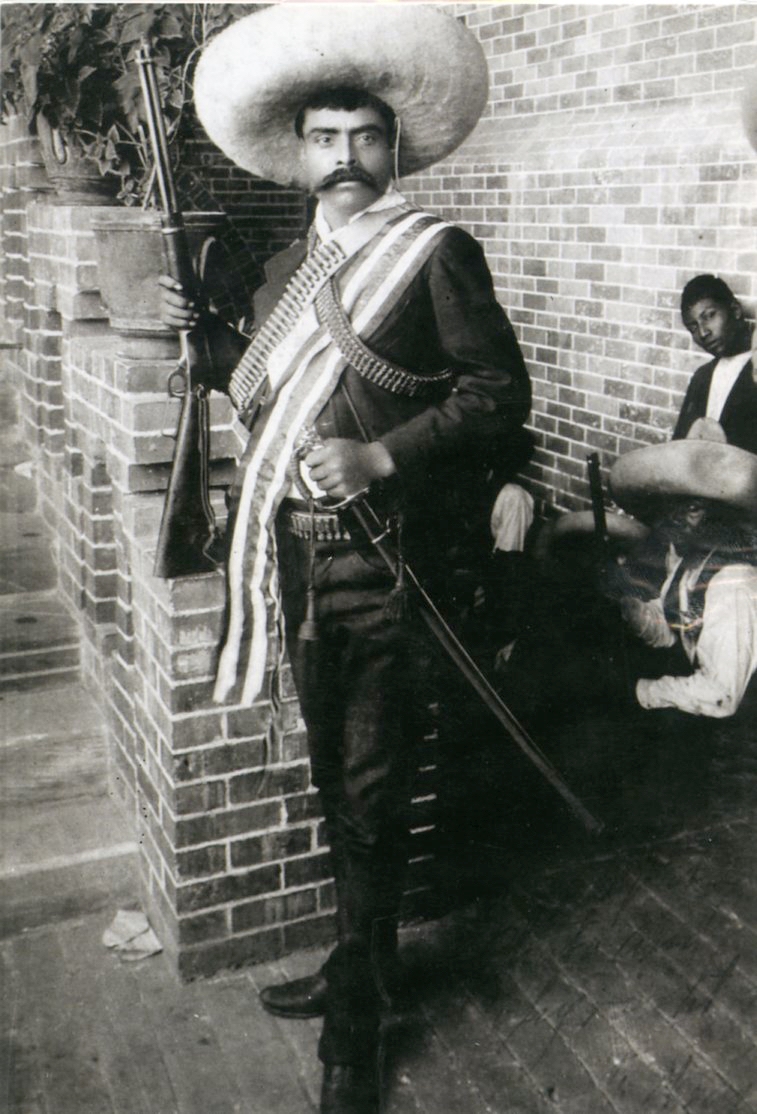
FAYETTEVILLE, Ark. – An international photo exhibit celebrating the life of Mexican icon Emiliano Zapata will be on display April 4-15 in the atrium of The David and Barbara Pryor Center for Arkansas Oral and Visual History at One East Center Street on the Fayetteville Square.
The University of Arkansas is one of three universities – including the University of Notre Dame and the Universidad de los Andes in Bogotá, Colombia – to host the photo exhibit.
It is one of several events being held at the Pryor Center in commemoration of the 100th anniversary of Zapata’s death.
These events will include a public lecture, a bilingual community celebration, and a film screening.
The exhibit, “Emiliano Zapata: 100 años, 100 fotos / Emiliano Zapata: 100 years, 100 photographs” depicts the life of Zapata, who was a champion of agrarian and indigenous rights, and for many is a national hero who represented the idealism of the Mexican Revolution.
“The image and symbol of Emiliano Zapata has been carefully cultivated for decades, but popular forces both in Mexico and in the Mexican American diaspora in the United States have challenged the official image, and people identify with Zapata for their own reasons,” said professor Paul Hart of Texas State University, who will give an exhibit-related talk on April 4.
The photographs in the exhibit are from the Casasola Collection, one of the primary archives of the Mexican Revolution.
The U of A exhibit is curated by faculty and students associated with the J. William Fulbright College of Arts and Sciences’ Latin American and Latino Studies Program and experts from Art Emporium who mounted the photographs for public viewing.
All of the events being held at the Pryor Center are free and open to the public.
These include:
- Re-remembering Zapata: Managed Memory and Contested Meaning
5 p.m. Thursday, April 4
Professor Paul Hart of Texas State University is the director of the Center for International Studies, and he recently published Emiliano Zapata: Mexico’s Social Revolutionary. In this talk, he will explore why Zapata remains relevant today as a symbol of resistance and hope, how his memory and meaning remain contested territory, and how history is used to shape the present.
- Opening Reception for Emiliano Zapata: 100 años, 100 fotos / Emiliano Zapata: 100 years, 100 photographs Exhibit
6:30-8 p.m. Thursday, April 4
Rodolfo Quilantán Arenas, Cónsul of México in Little Rock, will give the reception’s opening remarks and talk about the Casasola Collection and Zapata’s legacy.
- Zapata’s Legacy Today
4-6 p.m. Saturday, April 6
This family-friendly, bilingual community celebration will feature music and folksongs, games and crafts for children, food and fun. Featured guests will also include musician Al “Papa Rap” Lopez and Fayetteville Mayor Lioneld Jordan.
- Film Screening of Viva Zapata
5 p.m. Thursday, April 11
The 1952 film Viva Zapata — directed by Elia Kazan and starring Marlon Brando, Jean Peters and Anthony Quinn — tells the story of Mexican revolutionary Emiliano Zapata, who led the rebellion against the dictatorship of Porfirio Diaz in the early 20th century.
For more information, please call the Pryor Center at 479-575-6829.
Partners and sponsors for these events and the exhibit include the Consulate of Mexico in Little Rock, Art Emporium, University Libraries, La Oficina Latina, the Honors College, The David and Barbara Pryor Center for Arkansas Oral and Visual History, the J. William Fulbright College of Arts and Sciences’ Latin American and Latino Studies Program, Humanities Program and Comparative Literature and Cultural Studies Program, as well as the Department of World Languages, Literatures and Cultures, Department of History, Department of Sociology and Criminology, School of Journalism and Strategic Media and the Diane D. Blair Center of Southern Politics and Society.
About the Casasola Collection: The Casasola Collection is inspired by Agustín Victor Casasola, a Mexican photographer and co-founder of the Mexican Association of Press Photographers. He worked for several newspapers in Mexico City in the early 20th century shooting images of daily life, Mexican presidents, and other aspects of Mexican culture. A prolific photographer, Casasola captured or collected hundreds of images of the revolutionary struggle, including images of Emiliano Zapata.
About the J. William Fulbright College of Arts and Sciences: The J. William Fulbright College of Arts and Sciences is the largest and most academically diverse unit on campus with three schools, 16 departments and 43 academic programs and research centers. The college provides the core curriculum for all University of Arkansas students and is named for J. William Fulbright, former university president and longtime U.S. senator.
About the University of Arkansas: The University of Arkansas provides an internationally competitive education for undergraduate and graduate students in more than 200 academic programs. The university contributes new knowledge, economic development, basic and applied research, and creative activity while also providing service to academic and professional disciplines. The Carnegie Foundation classifies the University of Arkansas among only 2.7 percent of universities in America that have the highest level of research activity. U.S. News & World Report ranks the University of Arkansas among its top American public research universities. Founded in 1871, the University of Arkansas comprises 10 colleges and schools and maintains a low student-to-faculty ratio that promotes personal attention and close mentoring.
Topics
- Belonging
- Lectures, Colloquia & Symposia
- Politics & Government
- Events
- Humanities
- Social Sciences
- Cultural Events
- Fulbright College of Arts & Sciences
- Honors College
- University Libraries
- Comparative Literature and Cultural Studies Program
- Department of History
- School of Journalism & Strategic Media
- Latin American and Latino Studies Program
- Department of World Languages, Literatures and Cultures
- Department of Sociology and Criminology
Contacts
Steve Voorhies, manager of media relations
University Relations
479-575-3583,
voorhies@uark.edu
Andra Parrish Liwag, development writer
Fulbright College of Arts and Sciences
479-575-4393,
liwag@uark.edu